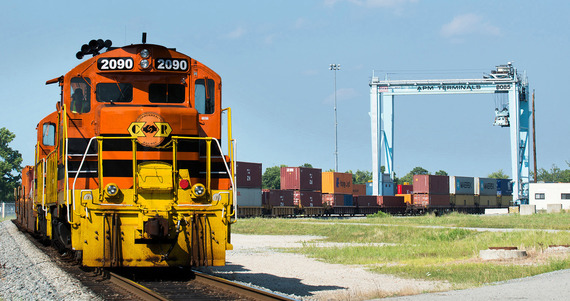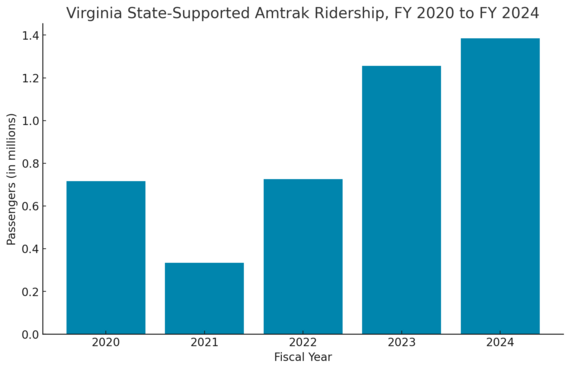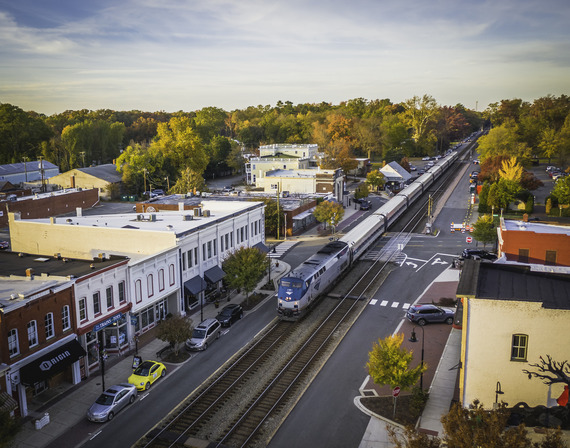|
|
Welcome to the Department of Rail and Public Transportation’s Data Stories, and thank you for signing up! This monthly series offers engaging data-driven narratives on Virginia’s rail and public transportation using the performance data DRPT collects. This month, we explore Virginia’s rail network and DRPT’s rail programs by the numbers.
Virginia’s rail history goes back to 1837 when the Richmond, Fredericksburg and Potomac Railroad was completed and began operations. Since then, Virginia’s rail network has expanded to serve all corners of the Commonwealth, connecting passengers and goods to the region, nation, and the world through the Port of Virginia. DRPT is the Virginia agency charged with supporting freight rail (through the Rail Industrial Access, Rail Preservation, and Freight programs) and planning for statewide freight and passenger rail improvements. This month’s Data Story will go through the basics of Virginia’s rail network, to the programs that DRPT runs, and the future of rail in Virginia.
|
|
Rail in Virginia 101

|
|
Virginia’s railroad network spans some 3,050 miles, according to 2021 data from the American Association of Railroads. That puts Virginia in 21st in terms of rail network size, out of the 49 states (and DC) that have railroads. Virginia outperforms its rail network rankings in terms of freight rail carloads originating or terminating in Virginia, coming in 13th for carload origin and 10th for carload termination. Those carloads carry a variety of goods, ranging from coal and chemicals, to food products or paper pulp.
The freight rail companies who own and operate Virginia’s rail network range from small, shortline railroads that serve a handful of customers in a small area to fortune-500 companies that employ tens of thousands of employees and own thousands of miles of track. The table below lists the freight rail operators in Virginia:
|
|
|
Passenger Rail
Virginia has two passenger rail providers that operate daily services: Amtrak and the Virginia Railway Express. Amtrak connects millions of passengers to points north, south, and west of Virginia through its state-supported and long-distance network. Virginia contracts with Amtrak to provide state-supported services. The Virginia Railway Express provides weekday, rush-hour service along the I-95 and I-66 corridor into Washington D.C., moving Virginians quickly and safely from home to work and vice versa.
The Virginia Passenger Rail Authority is working to improve passenger rail service in Virginia, making improvements to the rail network and adding service. As these improvements progress, Virginia has continually improved upon its own Amtrak ridership records year over year, moving nearly 1.4 million people in Fiscal Year 2024. The chart below visualizes Virginia’s Amtrak ridership growth:
 Source: Virginia Passenger Rail Authority. Note: Only includes Virginia state-supported Amtrak ridership. Amtrak long-distance trains (Cardinal, Crescent, Auto-train, Palmetto, Silver Service) and the North Carolina state-supported Carolinian are not included.
DRPT supports the freight rail industry in Virginia through technical assistance, grants, and statewide planning. DRPT’s grant programs promote improving infrastructure, expanding the network capacity, and economic development through industrial access development. DRPT’s grant programs for the rail industry are below:
-
Rail Preservation
- Supports Virginia’s shortline railroads, to retain and improve the shortline railway network and support facilities for freight service.
-
Rail Industrial Access
-
Funds the construction, rehabilitation, or design of rail spurs that connect businesses and industry to the rail network, promoting investment in businesses, attracting new or expanding industries, and diverting trucks from Virginia’s highways.
-
Freight Fund
- Supports adding capacity to Virginia’s freight rail network by supporting maintenance, infrastructure, rolling stock and rail facility improvements, engineering and design, and acquiring of right-of-way.
One metric DRPT uses to gauge the performance of its rail programs is the number of trucks diverted. Truck diversion is a proxy for the impact of DRPT’s rail programs, estimating the number of trucks that would have to be on Virginia’s roads and highways every year in order to move the same amount of freight. This is estimated by taking the number of rail carloads and multiplying it by 3.4, which is the average amount of trucks it takes to move one rail carload. The table below shows the total numbers of trucks taken off Virginia’s roads and highways and the corresponding number of rail carloads by DRPT’s rail programs from 2017 to 2023.
|
|
That is not all. DRPT’s Rail Industrial Access program also collects additional performance measures for its projects. This includes total capital investment, the number of jobs added to Virginia’s economy, as well as the number of trucks taken off of Virginia’s roads and highways. The RIA Dashboard can be found on DRPT’s Open Data Portal. |
|

The Future of Rail in Virginia
Virginia’s rail network will only continue to grow. In 2022, DRPT released the updated Statewide Rail Plan, as required by the Federal Railroad Administration, that outlines the future of and identifies future projects for freight and passenger rail in Virginia. The 2022 Statewide Rail Plan incorporates passenger rail projects and enhancements undertaken by the Virginia Passenger Rail Authority, as well as the potential improvements and investments to the freight rail network (across Class-I and shortline railroads) to grow Virginia’s network and economy. The Statewide Rail Plan will serve as Virginia’s guide for the future of rail. To find the interactive statewide rail plan, click here.
Virginia’s rail network is historic, extensive, and important to the future of the Commonwealth. DRPT continues to partner with rail providers to benefit Virginia’s economy, roads, and environment. In addition to providing ongoing technical support to Virginia’s railroads and continuing its grant programs, DRPT is studying the potential for economic development opportunities centered on rail in the Lynchburg region. Additionally, DRPT is taking the lead on the Corridor ID program for Virginia, which will guide the development of future passenger rail services in Virginia. Be sure to stay subscribed to DRPT’s newsletters for future news on the results of these studies!
|
|
DRPT’s mission is to connect and improve the quality of life for all Virginians with innovative transportation solutions. The SYIP turns that mission into action, by funding rail and public transportation priorities. With funding from the SYIP, transit agencies across Virginia provide over 10 million trips per month on buses, light rails, and subways. Freight rail programs divert around 14 million trucks from Virginia’s roads and attract hundreds of new jobs. Having trouble viewing this email? View it as a Web page. |
|
|
|
|